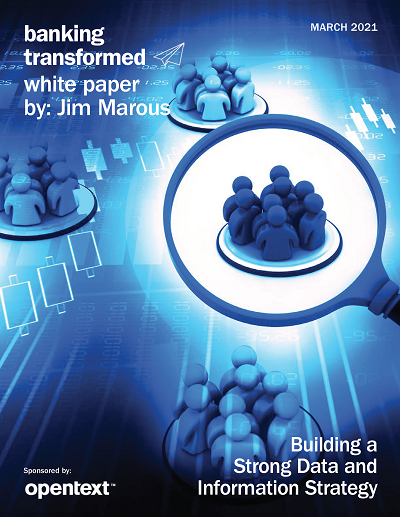Building a Strong Data and Information Strategy
White Paper
Jim Marous
March 2021
: DBR 277
31 pages, 16 tables/charts
Download Printable Version of this page
When we discuss digital banking transformation, a conversation about using data and analytics to improve the customer experience is where most financial services executives will start. This is because, more than ever, the power of data and customer insight can drive most decisions, and impact the revenue and cost components of a bank and credit union, more than any component of digital transformation.
The challenge has been that, despite a wealth of data at financial institutions, the ability to convert raw data into insights that are actionable has been mostly kept in the hands of a few data analysts with the skills and understanding necessary to properly collect, organize, analyze and interpret the data for their organization. Even these trained analysts had trouble with data stored in multiple silos, where a unified view of the customer was almost impossible.
But, with the emergence of technologies capable of bringing multiple silos of data together under one platform, data and the insights from advanced analytics are now shareable and interpretable for non-data analysts. Data democratization allows data and robust customer information to be used by all business units within a company, improving business decisions as well as customer experiences, at scale, in real-time.
“Data democratization means that everybody has access to data and there are no gatekeepers that create a bottleneck at the gateway to the data. The goal is to have anybody use data at any time to make decisions with no barriers to access or understanding,” says Bernard Marr, best-selling author of “Big Data in Practice.”
With strong customer information management, advanced platforms, supportive leadership team, data-driven culture, and data democratization, team members will be encouraged to use the same dataset as all others in the organization to make decisions, serve the customer better, and streamline back-office processes.
For the power of data democratization to be maximized, data and insights need to be used by far more parts of the organization than just marketing. These areas should include the call center, all product and distribution departments, risk, compliance, and the legal department — with the focus being on both the optimization of internal decision making and improving the customer experience.
Working off the same real-time data and contextual insights, a variety of departments can bring fresh insights to the way the organization engages with the customer across the entire customer journey. This is the key to success for any organization embarking on a mission of digital banking transformation.
We would like to thank our friends at OpenText for their support of this timely white paper on the development of a stronger data strategy and information management system for financial services. We would also like to thank the over 200 representatives from financial services organizations who shared their perspectives on current data and insight processes.
We hope these insights provide the basis for debate and soul searching across the industry in 2021, helping your organization proceed aggressively in the pursuit of improved decision making and customer experiences.
Building a Strong Data and Information Strategy
Advanced Analytics, AI, Analytics, Artificial Intelligence, Bank, Banking, Big Data, Credit Union, CRM, Customer Experience, Digital Banking, Digital Lending, Digital Marketing, Digital Transformation, Engagement, Fintech, Innovation, Marketing, Mobile Banking, Payments, Personalization, Technology, Trends

